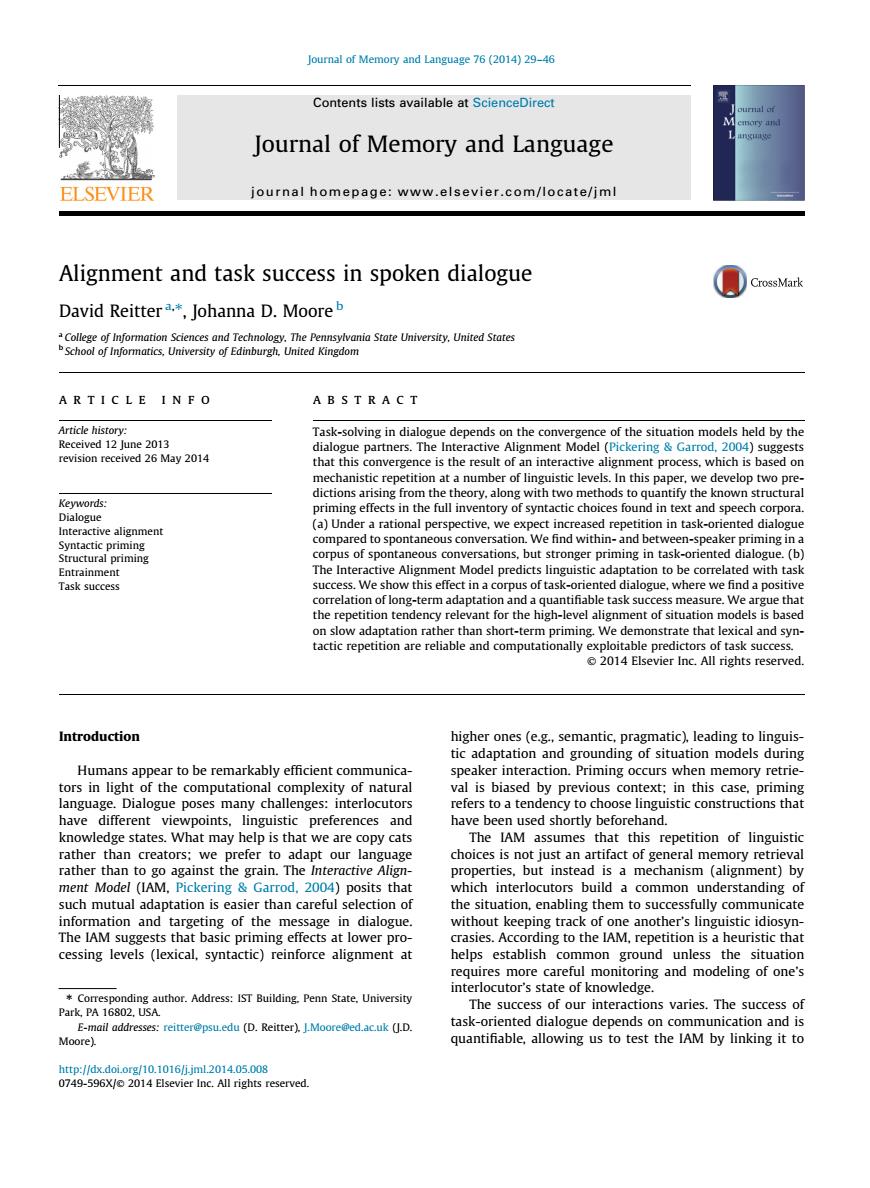正在加载图片...

Journal of Memory and Language 76(2014)9-6 Contents lists available at scienceDirect Journal of Memory and Language ELSEVIER journal homepage:www.elsevier.com/locate/jml Alignment and task success in spoken dialogue David Reitter,Johanna D.Moore ARTICLE INFO ABSTRACT anistic re uistic levels.In this e de The Int of sp Task success wth ogue.whe da po athe for the high-level ent o! 2014 Introduction Humans appear to be remarkably efficient communica speaker interaction.Priming occurs when memory tors in light of the computational complexity of natural val is biased by previousco have different vie oints linguistic preferences and have been used shortly beforehand. The IAM assume s that this repetition of linguistic cho rather than to ment Mod build a common understanding rgeting of the me dialogue 1.rel Thcutor's ns varies.The edu (D.Reitter)(D task-oriented dialogue depends on communication and is Moorel quantifiable.allowing us to test the IAM by linking it to Alignment and task success in spoken dialogue David Reitter a,⇑ , Johanna D. Moore b a College of Information Sciences and Technology, The Pennsylvania State University, United States b School of Informatics, University of Edinburgh, United Kingdom article info Article history: Received 12 June 2013 revision received 26 May 2014 Keywords: Dialogue Interactive alignment Syntactic priming Structural priming Entrainment Task success abstract Task-solving in dialogue depends on the convergence of the situation models held by the dialogue partners. The Interactive Alignment Model (Pickering & Garrod, 2004) suggests that this convergence is the result of an interactive alignment process, which is based on mechanistic repetition at a number of linguistic levels. In this paper, we develop two predictions arising from the theory, along with two methods to quantify the known structural priming effects in the full inventory of syntactic choices found in text and speech corpora. (a) Under a rational perspective, we expect increased repetition in task-oriented dialogue compared to spontaneous conversation. We find within- and between-speaker priming in a corpus of spontaneous conversations, but stronger priming in task-oriented dialogue. (b) The Interactive Alignment Model predicts linguistic adaptation to be correlated with task success. We show this effect in a corpus of task-oriented dialogue, where we find a positive correlation of long-term adaptation and a quantifiable task success measure. We argue that the repetition tendency relevant for the high-level alignment of situation models is based on slow adaptation rather than short-term priming. We demonstrate that lexical and syntactic repetition are reliable and computationally exploitable predictors of task success. 2014 Elsevier Inc. All rights reserved. Introduction Humans appear to be remarkably efficient communicators in light of the computational complexity of natural language. Dialogue poses many challenges: interlocutors have different viewpoints, linguistic preferences and knowledge states. What may help is that we are copy cats rather than creators; we prefer to adapt our language rather than to go against the grain. The Interactive Alignment Model (IAM, Pickering & Garrod, 2004) posits that such mutual adaptation is easier than careful selection of information and targeting of the message in dialogue. The IAM suggests that basic priming effects at lower processing levels (lexical, syntactic) reinforce alignment at higher ones (e.g., semantic, pragmatic), leading to linguistic adaptation and grounding of situation models during speaker interaction. Priming occurs when memory retrieval is biased by previous context; in this case, priming refers to a tendency to choose linguistic constructions that have been used shortly beforehand. The IAM assumes that this repetition of linguistic choices is not just an artifact of general memory retrieval properties, but instead is a mechanism (alignment) by which interlocutors build a common understanding of the situation, enabling them to successfully communicate without keeping track of one another’s linguistic idiosyncrasies. According to the IAM, repetition is a heuristic that helps establish common ground unless the situation requires more careful monitoring and modeling of one’s interlocutor’s state of knowledge. The success of our interactions varies. The success of task-oriented dialogue depends on communication and is quantifiable, allowing us to test the IAM by linking it to http://dx.doi.org/10.1016/j.jml.2014.05.008 0749-596X/ 2014 Elsevier Inc. All rights reserved. ⇑ Corresponding author. Address: IST Building, Penn State, University Park, PA 16802, USA. E-mail addresses: reitter@psu.edu (D. Reitter), J.Moore@ed.ac.uk (J.D. Moore). Journal of Memory and Language 76 (2014) 29–46 Contents lists available at ScienceDirect Journal of Memory and Language journal homepage: www.el sevier.com/locate/jml��